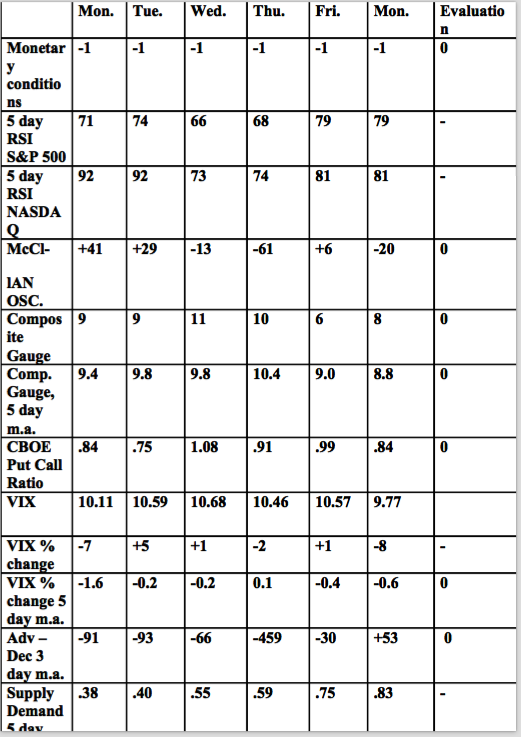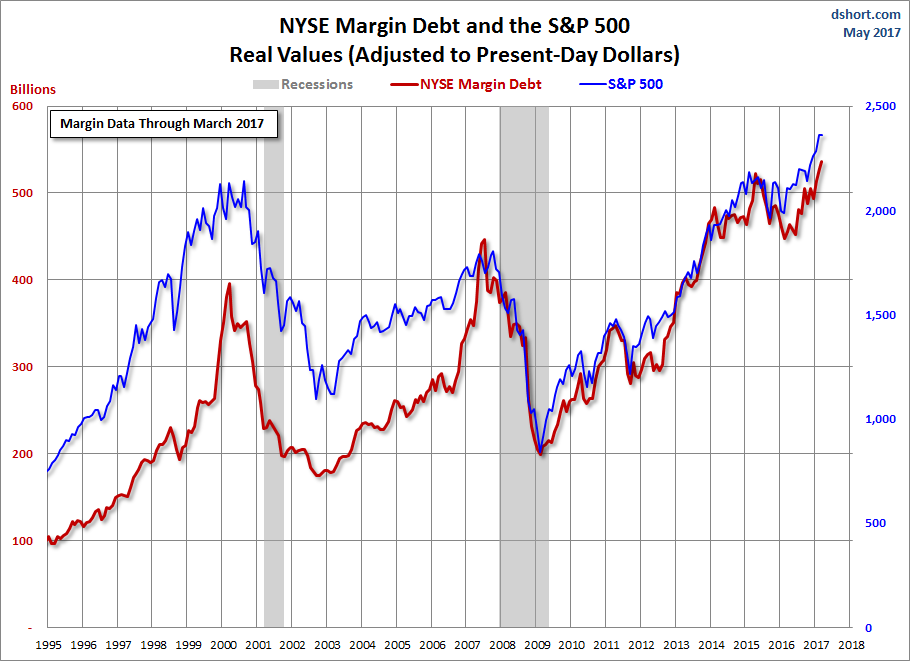Stocks & Equities
Sent to subscribers on May 11, 2017, 6:56 AM.
Briefly: In our opinion, speculative short positions are favored (with stop-loss at 2,410, and profit target at 2,200, S&P 500 index).
Our intraday outlook is bearish, and our short-term outlook is bearish. Our medium-term outlook remains neutral, following S&P 500 index breakout above last year’s all-time high:
Intraday outlook (next 24 hours): bearish
Short-term outlook (next 1-2 weeks): bearish
Medium-term outlook (next 1-3 months): neutral
Long-term outlook (next year): neutral
The main U.S. stock market indexes were mixed between -0.2% and +0.1% on Wednesday, extending their short-term fluctuations, as investors took short-term profits off the table. The S&P 500 index remains close to its Tuesday’s new all-time high at the level of 2,403.87. The index has broken slightly above the March 1 high on Tuesday, before closing lower by 0.1%. The Dow Jones Industrial Average remained below the level of 21,000, and the technology Nasdaq Composite index continued to trade above the level of 6,100. Will the broad stock market index continue its eight-year-long bull market? The nearest important level of support of the S&P 500 index is now at 2,390, marked by short-term local low. The next support level remains at 2,375-2,380, marked by the April 25 daily gap up of 2,376.98-2,381.15. The support level is also at 2,355-2,370, marked by the April 24 daily gap up. On the other hand, the nearest important level of resistance is at 2,400-2.405, marked by new record high, among others. We can see some volatility following six-month-long rally off last year’s November low at around 2,100. Is this a topping pattern before medium-term downward reversal? The uptrend accelerated on March 1 and it looked like a blow-off top pattern accompanied by some buying frenzy. The S&P 500 index is currently trading along its medium-term upward trend line, as we can see on the daily chart:
Expectations before the opening of today’s trading session are slightly negative, with index futures currently down 0.1-0.2%, as the market extends its short-term consolidation. The main European stock market indexes have been mixed so far. Investors will now wait for some economic data announcements: Initial Claims, Producer Price Index, Core Producer Price Index at 8:30 a.m. The market expects that the Producer Price Index along with Core Producer Price Index grew 0.2% in April. The S&P 500 futures contract trades within an intraday downtrend, as it retraces some of its yesterday’s late-session advance. The nearest important level of support is now at around 2,385-2,390, marked by previous local highs. The next support level remains at 2,375-2,380, marked by previous short-term local lows. The support level is also at 2,365, marked by previous consolidation. On the other hand, resistance level is at around 2,400-2,405, marked by March topping consolidation, and the new all-time high slightly above 2,400 mark. Will the market break above two-month long consolidation? Or is this just another upward correction? We can see some medium-term negative technical divergences, but will they lead to a downward correction?
The technology Nasdaq 100 futures contract remains relatively stronger than the broad stock market, as it is currently trading just 0.4% below its Tuesday’s new record high of around 5,690, following better-than-expected quarterly corporate earnings releases. The nearest important support level is at around 5,650, marked by previous resistance level. The next support level is at 5,630-5,640. The support level is also at 5,600, marked by previous short-term consolidation. On the other hand, level of resistance is at around 5.690-5,700. There have been no confirmed negative signals so far. However, we can see short-term overbought conditions:
Concluding, the S&P 500 index reached new all-time high at the level of 2,403.87 on Tuesday. However, it failed to continue short-term uptrend, as it gained just 0.1% on Wednesday. The broad stock market is still relatively weaker than the record-breaking technology Nasdaq Composite index. Will the broad stock market continue towards more new record highs? The index is currently trading along its six-month-long medium-term upward trend line. There have been no confirmed negative signals so far. However, we still can see medium-term negative technical divergences. Therefore, we continue to maintain our speculative short position (opened on February 15 at 2,335.58 – opening price of the S&P 500 index). Stop-loss level is at 2,410 and potential profit target is at 2,200 (S&P 500 index). You can trade S&P 500 index using futures contracts (S&P 500 futures contract – SP, E-mini S&P 500 futures contract – ES) or an ETF like the SPDR S&P 500 ETF – SPY. It is always important to set some exit price level in case some events cause the price to move in the unlikely direction. Having safety measures in place helps limit potential losses while letting the gains grow.
To summarize: short position in S&P 500 index is justified from the risk/reward perspective with the following entry prices, stop-loss orders and profit target price levels:
S&P 500 index – short position: profit target level: 2,200; stop-loss level: 2,410
S&P 500 futures contract (June) – short position: profit target level: 2,197; stop-loss level: 2,407
SPY ETF (SPDR S&P 500, not leveraged) – short position: profit target level: $220; stop-loss level: $241
SDS ETF (ProShares UltraShort S&P500, leveraged: -2x) – long position: profit target level: $15.47; stop-loss level: $12.98
Thank you.
Paul Rejczak
Stock Trading Strategist

The CBOE Volatility Index, or VIX, which serves as stock market fear gauge and on Monday closed at its lowest level since 1993.
The equity chief at one of Wall Street’s biggest firms breaks down the hottest story in markets right now
The equity market is quiet — some might say too quiet.
It’s a development that’s confounded Wall Street traders and strategists alike for weeks. They’ve debated whether the environment is as calm as it seems, or if the depressed VIX is masking a stock market shock brewing under the surface.

Another measure of Market Sentiment:
To see how each of the 7 indicators are trending go HERE
…related:

3:00pm PST Monday May 8, 2017
DOW + 5 on 350 net declines
NASDAQ COMP + 2 on 350 net declines
SHORT TERM TREND Bearish
INTERMEDIATE TERM Bullish
STOCKS: The markets got what they wanted in the French election, but it was discounted last week. Today was sell the news.
The market is quite overbought by many measures. That by itself would not render a short term sell signal, but when you consider the underlying breadth, it makes us a bit cautious. We cover this more in the chart section below.
Any multi day retreat from current levels should provide an opportunity. The intermediate trend remains quite positive.
GOLD: Gold was flat. Not much happening here, but it is oversold.
CHART The S&P has been up 5 out of the past 7 days, but breadth has been down 5 out of the past 7 days. There are no guarantees in this business, but that is normally a short term negative. Sorry to use the same chart so often lately, but it’s the most important consideration currently.

BOTTOM LINE: (Trading)
Our intermediate term system is on a buy.
System 7 We are in cash stay on the sidelines for now.
System 8 We are in cash. Stay there.
System 9 We are in cash. Stay there.
NEWS AND FUNDAMENTALS: There were no important economic releases on Monday. I couldn’t access my source for Tuesday.
TORONTO EXCHANGE: Toronto gained 70.
BONDS: Bonds made another low.
THE REST: The dollar had a sharp rebound. Silver was flat. Crude oil managed a small gain.
Bonds –Bearish as of May 1.
U.S. dollar -Bearish as of May 4.
Euro — Bullish as of May 4.
Gold —-Bearish as of April 19.
Silver—- Bearish as of April 19.
Crude oil —- Move to bullish as of today May 5.
Toronto Stock Exchange—- Bullish from January 22, 2016
We are on a long term buy signal for the markets of the U.S., Canada, Britain, Germany and France. INDICATOR PARAMETERS

Monetary conditions (+2 means the Fed is actively dropping rates; +1 means a bias toward easing. 0 means neutral, -1 means a bias toward tightening, -2 means actively raising rates). RSI (30 or below is oversold, 80 or above is overbought). McClellan Oscillator ( minus 100 is oversold. Plus 100 is overbought). Composite Gauge (5 or below is negative, 13 or above is positive). Composite Gauge five day m.a. (8.0 or below is overbought. 13.0 or above is oversold). CBOE Put Call Ratio ( .80 or below is a negative. 1.00 or above is a positive). Volatility Index, VIX (low teens bearish, high twenties bullish), VIX % single day change. + 5 or greater bullish. -5 or less, bearish. VIX % change 5 day m.a. +3.0 or above bullish, -3.0 or below, bearish. Advances minus declines three day m.a.( +500 is bearish. – 500 is bullish). Supply Demand 5 day m.a. (.45 or below is a positive. .80 or above is a negative). Trading Index (TRIN) 1.40 or above bullish. No level for bearish.
No guarantees are made. Traders can and do lose money. The publisher may take positions in recommended securities.

Note: The NYSE has released new data for margin debt, now available through March.
The New York Stock Exchange publishes end-of-month data for margin debt on the NYX data website, where we can also find historical data back to 1959. Let’s examine the numbers and study the relationship between margin debt and the market, using the S&P 500 as the surrogate for the latter.
The first chart shows the two series in real terms — adjusted for inflation to today’s dollar using the Consumer Price Index as the deflator. At the 1995 start date, we were well into the Boomer Bull Market that began in 1982 and approaching the start of the Tech Bubble that shaped investor sentiment during the second half of the decade. The astonishing surge in leverage in late 1999 peaked in March 2000, the same month that the S&P 500 hit its all-time daily high, although the highest monthly close for that year was five months later in August. A similar surge began in 2006, peaking in July 2007, three months before the market peak.
Debt hit a trough in February 2009, a month before the March market bottom. It then began another major cycle of increase.
The Latest Margin Data
The NYSE has released new data for margin debt, now available through March. The latest debt level is up 1.7% month-over-month. The current level is at another record high. Note the inflation-adjusted version is also at its record high. The March data gives us an additional sense of investor behavior since the start of the new administration.


Quick take: At the end of April the inflation-adjusted S&P 500 index price was 97% above its long-term trend, unchanged from the previous month.
About the only certainty in the stock market is that, over the long haul, over performance turns into under performance and vice versa. Is there a pattern to this movement? Let’s apply some simple regression analysis (see footnote below) to the question.

…also from Advisor Perspectives:
















